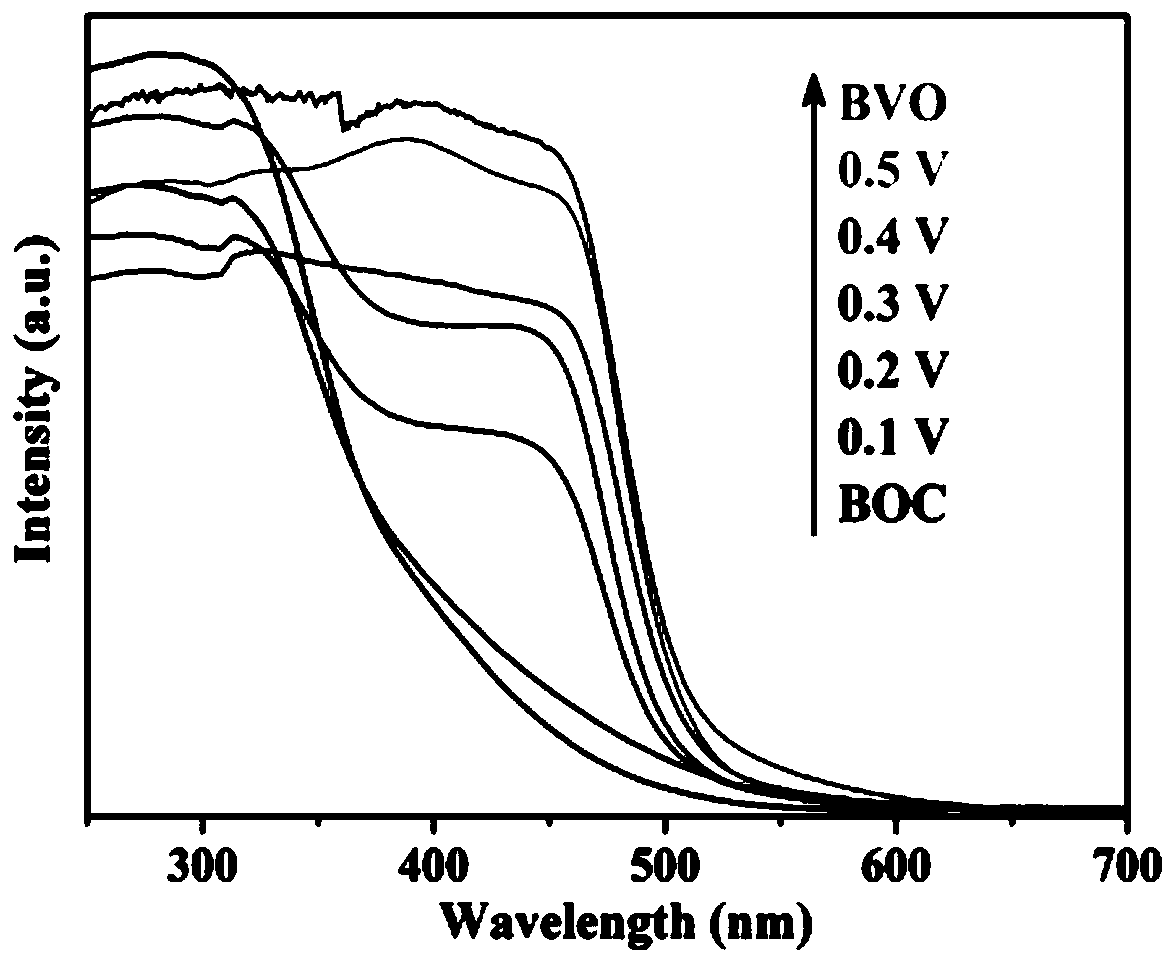A method for synthesizing heterojunction photocatalysts by ion exchange method
A technology of ion exchange method and photocatalyst, which is applied in the field of preparation of heterojunction photocatalyst to achieve the effect of improved transfer and separation efficiency, small size and good dispersion
- Summary
- Abstract
- Description
- Claims
- Application Information
AI Technical Summary
Problems solved by technology
Method used
Image
Examples
Embodiment 1
[0027] Example 1 Bi 12 o 15 Cl 6 / BiVO 4 Preparation of photocatalyst
[0028] Weigh 0.9701g bismuth nitrate pentahydrate and 0.0464g ammonium chloride respectively, and control the molar ratio of the two to be 3:1.3; dissolve bismuth nitrate and ammonium chloride in 10ml ethylene glycol and 20ml deionized water respectively by ultrasonic stirring, and Slowly add the ethylene glycol solution containing bismuth nitrate into the ammonium chloride solution dropwise during continuous stirring, and continue to stir for 30 minutes, then transfer the mixed white solution to a hydrothermal kettle with a volume of 50mL, and heat it in an oven at 160°C. Medium hydrothermal reaction for 12 hours; after the reaction was completed, the white precipitate in the hydrothermal kettle was collected by centrifugation, washed three times alternately with deionized water and absolute ethanol, and then dried at 60°C to obtain Bi 12 o 15 Cl 6 Precursor; Bi 12 o 15 Cl 6 After the precursor w...
Embodiment 2
[0029] The prepared Bi of embodiment 2 12 o 15 Cl 6 / BiVO 4 Characterization analysis of photocatalyst
[0030] Such as figure 1 As shown, Bi 12 o 15 Cl 6 / BiVO 4 Heterojunction photocatalyst with Bi 12 o 15 Cl 6 and BiVO 4 The characteristic peaks indicate that we have successfully prepared Bi 12 o 15 Cl 6 / BiVO 4 heterojunction photocatalysts.
[0031] Such as figure 2 As shown, the figure a is pure Bi 12 o 15 Cl 6 , it can be seen that it is assembled from nano-sheets with a size of 100-200nm and a thickness of about 10nm; 12 o 15 Cl 6 / BiVO 4 Heterojunction, it can be observed from the figure that under the action of ion exchange of ammonium metavanadate, pure Bi 12 o 15 Cl 6 The surface and voids grow BiVO 4 Nano-nanoparticles, the size of heterojunction nanosheets is about 100-200nm; c picture shows pure BiVO 4 , it can be seen that it is a nanoparticle with a size of 100-200nm and a thickness of about 10nm.
[0032] Such as image 3 As sho...
Embodiment 3
[0036] Example 3 Bi 12 o 15 Cl 6 / BiVO 4 Visible light catalytic activity experiment of photocatalyst
[0037] (1) Prepare a tetracycline hydrochloride solution with a concentration of 10 mg / L, and store the prepared solution in a dark place.
[0038] (2) Weighing different Bi 12 o 15 Cl 6 / BiVO 4 50 mg of heterojunction photocatalysts (0.1V, 0.2V, 0.3V, 0.4V, 0.5V) were placed in the photocatalytic reactor respectively, and 100mL of the target pollutant solution prepared in step (1) was added, and ultrasonic Disperse evenly, stir magnetically for 30 minutes in the dark, turn on the cooling water source and light source, and conduct the photocatalytic degradation experiment.
[0039] (3) Use a sampler to draw 10 mL of the photocatalytic degradation solution in the reactor every 10 minutes, take the supernatant after centrifugation is complete, and measure the remaining tetracycline hydrochloride in the ultraviolet-visible absorption spectrometer.
[0040] (4) by Fig...
PUM
| Property | Measurement | Unit |
|---|---|---|
| thickness | aaaaa | aaaaa |
| size | aaaaa | aaaaa |
| thickness | aaaaa | aaaaa |
Abstract
Description
Claims
Application Information
 Login to View More
Login to View More - R&D
- Intellectual Property
- Life Sciences
- Materials
- Tech Scout
- Unparalleled Data Quality
- Higher Quality Content
- 60% Fewer Hallucinations
Browse by: Latest US Patents, China's latest patents, Technical Efficacy Thesaurus, Application Domain, Technology Topic, Popular Technical Reports.
© 2025 PatSnap. All rights reserved.Legal|Privacy policy|Modern Slavery Act Transparency Statement|Sitemap|About US| Contact US: help@patsnap.com



